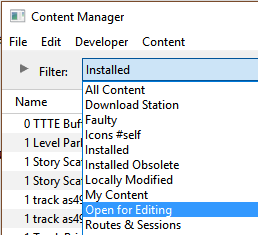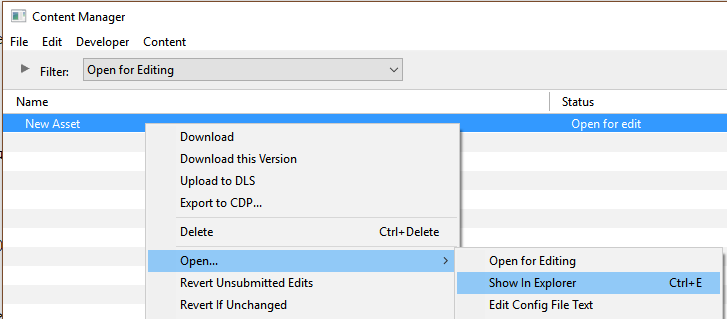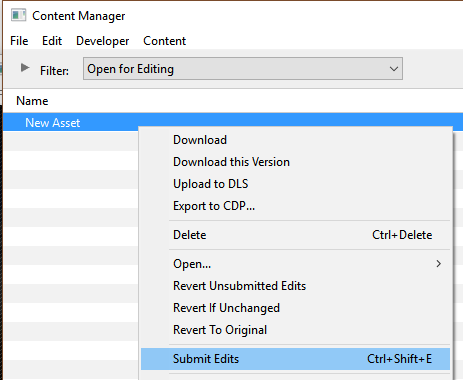How to Create a Region Asset
The information in this Wiki Page applies to TANE, TRS19 and Trainz Plus.
Contents |
What is a Region?
| A Region defines some of the characteristics of a geographic location (e.g. a country or a province) that is represented in a route | ||
| A Region Asset is a config.txt file that contains the region data |
How to Create a Region Asset
 Steps |
|
|||||||
|
|
||||||||
|
||||||||
|
|
||||||||
|
||||||||
|
|
||||||||
|
||||||||
|
|
||||||||
|
||||||||
|
|
||||||||
|
||||||||
|
|
||||||||
|
||||||||
The Config.txt File
This file should follow the same (or a similar) format as the example below.
- entries in blue are examples only and may/will be different for each asset
- the indenting of the lines and the spacing ("tabbing") between the "tags" on the left and their contents on the right are purely to make it easier for humans to read
- the use of the {} braces is to group tags into common "containers". These containers must not be broken up and the number of { characters must match the number of } characters
- the order of the "tags" is not important
kuid <kuid: this is an auto-generated number > kind "region" username "Tasmania 1950s/1960s Region" category-class "YX" category-era "1950s;1960s" category-region "AU" ontheright 0 water-color 75,128,255 defaultjunction <kuid:61119:24120> longitude 147.0,26.0,1.0 latitude 41,50,-1 altitude 212 car0 <kuid:61119:24120> trainz-build 4.3 thumbnails { Default { width 240 height 180 image "Tasmania-Region.jpg" } } description "Vehicle, road, water and geographic data for Tasmania (Australia) in the 1950s and 1960s" kuid-table { 0 kuid value 1 kuid value 2 kuid value }
|
|
|
| Settings: For the above example:
"icon_gradeXing.texture.txt") but the filename ending ".txt" is not added to the name in the texture tag so it would appear as "icon_gradeXing.texture"
|
|
|
|
|
| Language Options: | |
| All Trainz assets have a language facility built into their config.txt files that allows other language translations to be added for certain tags, such as the username and description tags. A full description of the process can be found on the Trainz Wiki at Localize an Asset and a list of all the supported languages with their two character codes at At the very basic level any creator can easily provide other language translations for the username and description tags in the assets they create. Examples are shown below for this sample asset. |
|
username "Tasmania 1950s/1960s region" username-c2 "" username-es "" username-fr "" username-gr "" username-nl "" username-ru "" |
|
| Translations to Chinese (simplified), Spanish, French, German, Dutch and Russian, perfect or not, were provided by Google Translate. | |
Category Era Tag
This identifies the decade or decades in which the region is based. Each decade name ends with an "s" (e.g. "1950s") and multiple consecutive decades can be specified by using a semi-colon (;) as a separator (e.g. "1950s;1960s"). A list of category-eras can be found at Category-era tag.
Category Region Tag
This identifies the country or countries in which the region is based. Each country has a two letter code (e.g. "AU" for Australia) and multiple countries can be specified by using a semi-colon (;) as a separator (e.g. "AU;UK;US"). If no country is to be specified then the two character code "00" (double zero) is used. A list of countries (category regions) can be found at Category-region tag.
On the Right Tag
This identifies which side of the road is used by road traffic in this region. 0 = left side, 1 = right side. This tag is compulsory in a Region asset.
Water Color Tag
| Warning: | |
| The water-color tag in a Region asset has been superceded by the Water Color Lighting Setting in TANE and TRS19 (Environment Tools) | |
This identifies the the colour used by water surfaces in this region. Three integers specify the RGB (Red, Green, Blue) colour values to be used. Each value is from 0 to 255 and are separated by commas (e.g. 75,128,255). This tag is compulsory in a Region asset with an asset build number of 3.4 and higher.
Default Junction Tag
This identifies the junction lever or switch that Trainz will use as its default lever asset whenever a lever is added to a track junction in this region. The lever asset must be identified by its kuid (e.g. <kuid:61119:24120>). This tag is compulsory in a Region asset with an asset build number of 3.4 and higher.
The kuid value of the switch lever must be added to the kuid-table container of the config.txt file.
Longitude Tag
This identifies the geographic longitude of a point in the region. Three values separated by commas must be supplied. The first is the longitude degrees;, the second is the longitude minutes and the third is the East/West value (1.0 = East, -1.0 = West). For example: 147.0,26.0,1.0 would represent longitude 147 degrees 26 minutes East. This tag is compulsory in a Region asset with an asset build number of 3.4 and higher.
Latitude Tag
This identifies the geographic latitude of a point in the region. Three values separated by commas must be supplied. The first is the latitude degrees;, the second is the latitude minutes and the third is the North/South value (1.0 = North, -1.0 = South). For example: 41,50,-1 would represent latitude 41 degrees 50 minutes South. This tag is compulsory in a Region asset with an asset build number of 3.4 and higher.
Altitude Tag
This identifies the altitude of the point in the region whose longitude and latitude has been given. The height is a single value in metres and is used in the display of snow effects for those assets that support snow. This tag is compulsory in a Region asset with an asset build number of 3.4 and higher.
Car Tags
This identifies the moving cars that will appear on roads in the region.
- Upto 15 different cars, each as a separate tag from car0 to car14 identifying their kuid values, can be specified in a region. The car numbers must be consecutive with no missing or duplicated entries
- The cars must be specifically created as moving vehicles and not as static vehicles - static car assets cannot be used
- car tags are not compulsory. If not used then no moving cars will appear
- Not all roads can carry moving vehicles
- The Environment Tool has a control that will enable and disable all road traffic
- The kuids of the cars must be added to the kuid-table container of the config.txt file
For example, the following entries will specify just 4 moving vehicles for the region.
car0 <kuid:329364:1568> car1 <kuid:309161:100599> car2 <kuid2:329364:1689:1> car3 <kuid2:329364:1707:1>
Kuid Table Tag
This must contain the kuid values of the Default Junction asset (if used) and all the cars specifed in the car tags. Using the examples shown above, the kuid-table would be (the kuid order is not important):-
kuid-table
{
0 <kuid:329364:1568>
1 <kuid:309161:100599>
2 <kuid2:329364:1689:1>
3 <kuid2:329364:1707:1>
4 <kuid:61119:24120>
}
The Thumbnail Image
| A thumbnail image MUST be present in the asset |
| Notes: The thumbnail image:-
|
Using the Asset
Once the new asset has been committed it will be available for use as a Region.
The region is specified when a new route is created and it can be altered by selecting Edit Route from the main menu in TANE or the edit menu in TRS19.
Trainz Wiki
 |
More Tutorials and Guides to Using Trainz |
This page was created by Trainz user pware in April 2020 and was last updated as shown below.






